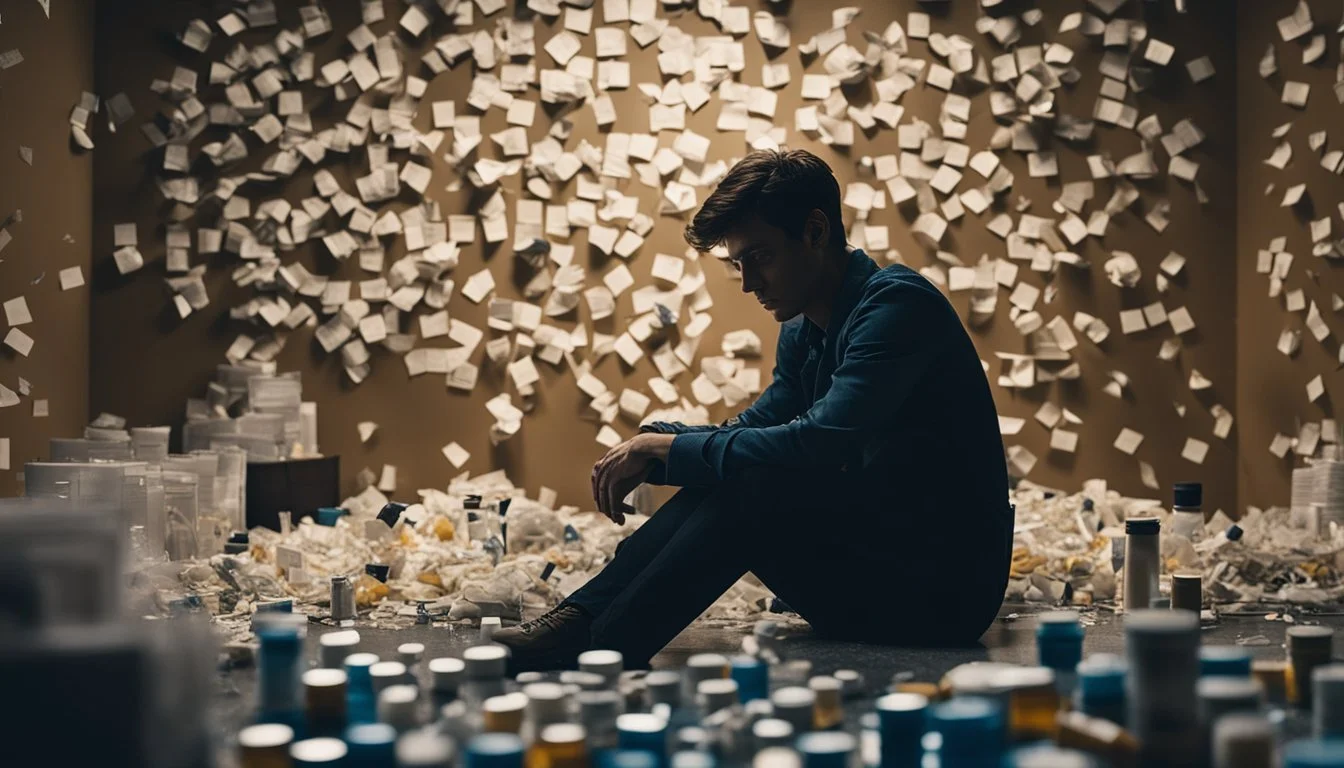8 Films That Humanize the Bipolar Experience
A Cinematic Exploration
Exploring the portrayal of bipolar disorder in film offers a window into understanding how media can shape perceptions of mental health conditions. Through these cinematic works, the complexities and realities of living with bipolar disorder are often highlighted, providing audiences with a deeper appreciation of the human side of the condition.
Films that humanize the bipolar experience can foster empathy and spark meaningful conversations about mental health. By depicting personal stories and struggles, the film serves as an educational tool, bridging the gap between clinical diagnoses and the lived human experience. This approach invites viewers to reflect on the diverse experiences of individuals with bipolar disorder, encouraging a broader dialogue on mental health awareness.
1) "Silver Linings Playbook" (2012)
"Silver Linings Playbook," directed by David O. Russell, offers a genuine exploration of mental health through its central character, Pat Solitano, played by Bradley Cooper. Pat grapples with bipolar disorder following a traumatic incident, leading to his hospitalization and a challenging journey towards recovery.
The film authentically portrays the emotional volatility and impulsivity associated with bipolar disorder. It provides insight into how Pat navigates his relationships with family, friends, and new acquaintance Tiffany Maxwell, portrayed by Jennifer Lawrence. Both characters embody the challenges and complexities of mental illness, adding depth to the narrative.
Family dynamics play a crucial role, with Robert De Niro and Jacki Weaver portraying Pat's parents, highlighting the familial impact of mental health struggles. The film balances humor and gravity, offering moments of levity while delving into serious themes.
For more information on "Silver Linings Playbook," visit IMDb.
2) "Infinitely Polar Bear" (2014)
"Infinitely Polar Bear" offers a nuanced exploration of bipolar disorder through the life of Cam Stuart, a father of two in a mixed-race family in Boston. Directed by Maya Forbes, the film portrays his struggle and the impact of his mental health on family dynamics.
The film stars Mark Ruffalo and Zoe Saldana, capturing the highs and lows of bipolar disorder with empathy and authenticity. It highlights both the challenges and the tender moments shared by the family, ensuring a balanced representation.
"Infinitely Polar Bear" made its premiere at the Sundance Film Festival and later saw a theatrical release in 2015. The film received attention for its ability to depict bipolar disorder without heavy-handed judgment, focusing instead on the human aspects of living with the condition.
For more information, visit the film's Wikipedia page.
3) "Touched with Fire" (2015)
"Touched with Fire" explores the lives of two poets who share a deep connection through their experiences with bipolar disorder. Directed by Paul Dalio, the film draws from his own personal encounters with the condition, giving it a unique authenticity.
The story follows Carla, played by Katie Holmes, who is a published poet. She represents a more high-functioning individual with bipolar disorder, providing insight into her struggles and triumphs. The film highlights the complexity of the condition and the emotional intensity of their relationship.
Dalio's vision for the film was inspired by the book "Touched With Fire" by Kay Redfield Jamison, which examines the link between creativity and bipolar disorder. This inspiration is evident in the movie's portrayal of the challenges and gifts associated with the condition.
By blending personal experience with artistic interpretation, "Touched with Fire" offers an insightful perspective on living with bipolar disorder. It seeks to foster understanding and empathy for those affected.
For more information, refer to IMDb or Wikipedia.
4) "Melancholia" (2011)
Lars von Trier's "Melancholia" is a film that intertwines cosmic disaster with a personal exploration of mental health. It follows Justine, played by Kirsten Dunst, through her battle with severe depression, amid an impending apocalypse.
The film captures the gravity of depression through its slow, deliberate pacing and somber visuals, emphasizing the weight that Justine feels. Her interactions with her dysfunctional family reveal layers of emotional and psychological distress.
Unlike many films, "Melancholia" does not shy away from portraying the bleakness of depression. It offers a stark depiction of how mental illness can permeate every aspect of life, even in the face of planetary doom.
This artistic approach to depicting depression provides an intense experience for viewers, showing the complexities and depth of the condition.
For further exploration of the film and its themes, visit "Melancholia" on IMDb.
5) "Mad Love" (1995)
"Mad Love" explores the intense relationship between two high school students, Matt Leland and Casey Roberts. It provides a deep look into Casey's struggle with bipolar disorder, highlighting the emotional challenges she faces.
Drew Barrymore plays the role of Casey, bringing a poignant authenticity to her character. Her performance illustrates how bipolar disorder affects relationships and the individuals involved.
Chris O'Donnell, as Matt, navigates the complexities of loving someone with a mental disorder. The film adds depth by showing his perspective and the strain on their relationship.
"Mad Love" stands out by capturing the raw and sensitive nature of teenage love intertwined with mental health issues. Its portrayal helps in understanding the impact of bipolar disorder on young adults.
More about "Mad Love" on IMDb
6) "Replicas" (2018)
In "Replicas," a science fiction thriller film, the story addresses the impact of trauma and ethical boundaries. It follows neuroscientist Will Foster, portrayed by Keanu Reeves, who is determined to bring his family back after a fatal accident, exploring themes of grief and desperation that resemble emotional struggles faced in bipolar disorder.
Will’s actions raise ethical questions as he attempts to transplant human consciousness into cloned bodies. This quest reflects the complexities of making drastic decisions amidst emotional turmoil, which can resonate with those experiencing heightened emotional states.
Foster’s journey depicts the lengths one might go to in dealing with loss, pain, and the desire to preserve happiness. While the film centers on sci-fi elements, it highlights the profound effects of trauma on mental health and decision-making.
The film engages with complex emotions through its narrative, offering insights into the extremes that drive human behavior in challenging situations. By focusing on human experiences, "Replicas" provides a narrative that aligns with the understanding of mental health challenges. Learn more about "Replicas" on IMDb.
7) "The Glass Castle" (2017)
"The Glass Castle" is a biographical drama film centered on the memoir by Jeannette Walls. This film offers a powerful look into the complexities of a family struggling with poverty and instability.
Set against the backdrop of a nomadic lifestyle, the story captures Walls' challenging upbringing. The film explores themes of emotional and psychological neglect. Jeannette's parents, portrayed by Naomi Watts and Woody Harrelson, exhibit behaviors that create a tumultuous environment for their children.
In particular, the film provides insight into the mental health issues faced by her father. His actions, influenced by his unpredictable and often destructive nature, impact the family in deep and lasting ways. "The Glass Castle" effectively illustrates the dual nature of his character, at times loving and at others, profoundly damaging.
Portrayed by Brie Larson, Walls navigates the challenges of growing up in such a family. Despite the adversity and her father’s struggles, which are depicted with raw realism, she eventually finds her path to success and stability.
The candid depiction of Walls' journey emphasizes the resilience of the human spirit. This film makes a significant contribution to the conversation around mental health, showing the impact of a parent's mental illness on the family dynamic.
Learn more about "The Glass Castle" on Wikipedia.
8) "Girl, Interrupted" (1999)
"Girl, Interrupted" is a psychological drama film based on Susanna Kaysen's memoir. The film offers a profound look into the life of Kaysen, who is portrayed by Winona Ryder. Set in the 1960s, it details her 18-month stay in a mental institution after being diagnosed with borderline personality disorder.
The movie delves into the complexities of mental health, emphasizing empathy and compassion in its portrayal. Through her journey, Kaysen encounters a diverse group of women with different mental health challenges, each adding depth to the narrative. This ensemble cast, including Angelina Jolie, showcases the varied human experiences within the institution.
By highlighting the personal stories and struggles of these women, "Girl, Interrupted" sheds light on the multifaceted nature of mental illness. It invites viewers to reflect on the stigma often associated with mental health disorders, fostering a better understanding.
"Girl, Interrupted" stands as a compelling representation of the mental health experience, utilizing powerful performances and storytelling. These elements create a poignant narrative that engages audiences and encourages thoughtful reflection.
For more information on the film, visit Wikipedia or IMDb.
Understanding Bipolar Disorder
Bipolar disorder is a severe mental health condition that affects mood regulation, often resulting in extreme emotional states. Key aspects include understanding its types, symptoms, and the process by which it is diagnosed.
Definition and Types
Bipolar disorder is categorized by significant shifts in mood, energy, and behavior. It primarily manifests in two types: Bipolar I Disorder and Bipolar II Disorder.
Bipolar I involves at least one manic episode, which may be followed by depressive states. Manic episodes are marked by high energy, reduced need for sleep, and sometimes risky behavior.
Bipolar II is characterized by hypomanic episodes that are less severe than full mania, accompanied by periods of depression. Cyclothymic disorder represents a milder form, with oscillations between hypomania and mild depression.
Symptoms and Diagnosis
Symptoms of bipolar disorder vary between manic and depressive phases. During manic episodes, individuals may experience grandiosity, talkativeness, or racing thoughts. Depressive episodes may involve feelings of sadness, hopelessness, or difficulty concentrating.
Diagnosis is complex and involves thorough clinical evaluation. A healthcare provider may use mood charting and conduct interviews with family and friends. Criteria from the Diagnostic and Statistical Manual of Mental Disorders (DSM-5) guide the diagnostic process.
Early diagnosis and intervention are crucial for effective management. Understanding the signs and symptoms allows for timely medical advice and treatment options. Proper management can significantly improve quality of life by stabilizing mood swings and addressing related challenges.
The Role of Film in Shaping Perceptions
Films have a profound effect on shaping perceptions, especially concerning mental health conditions like bipolar disorder. By portraying characters with depth and nuance, they break stereotypes and foster greater empathy and understanding.
Impact on Public Awareness
Movies play a crucial part in increasing public awareness of bipolar disorder. By capturing the complexities of the condition, films shed light on symptoms, struggles, and daily challenges faced by individuals. Awareness arises not only from characteristic depictions but also from engaging narratives that invite audience reflection.
Through these portrayals, viewers learn about common misconceptions, reducing stigma and fostering informed discussions.
Balancing Entertainment with Reality
Balancing entertainment with reality is essential in films depicting bipolar disorder. While storytelling requires drama, accuracy remains vital for responsible portrayal. Filmmakers face the challenge of depicting manic and depressive episodes realistically while maintaining narrative engagement.
Films that achieve this balance offer entertainment while educating viewers about the authenticity of living with bipolar disorder. Such portrayals help audiences relate to the experiences and reshape their understanding, avoiding stereotypes and simplistic representations.




